Swords of Rorby - curved swords from the Bronze Age
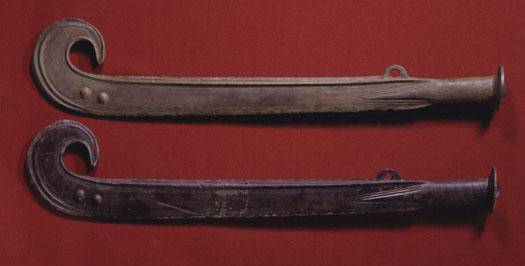
Here they are - the unique swords of Rorby.
I have already written here that the first swords in Europe were long “foils” for fencing with blades without handles. Both knives and daggers were made in the same way: only the blade itself was cast, which expanded in the rear, where there were holes for rivets: 2, 3, 4, 5, etc. In the wooden handle was made propyl, into which the blade was inserted and then fastened with rivets.
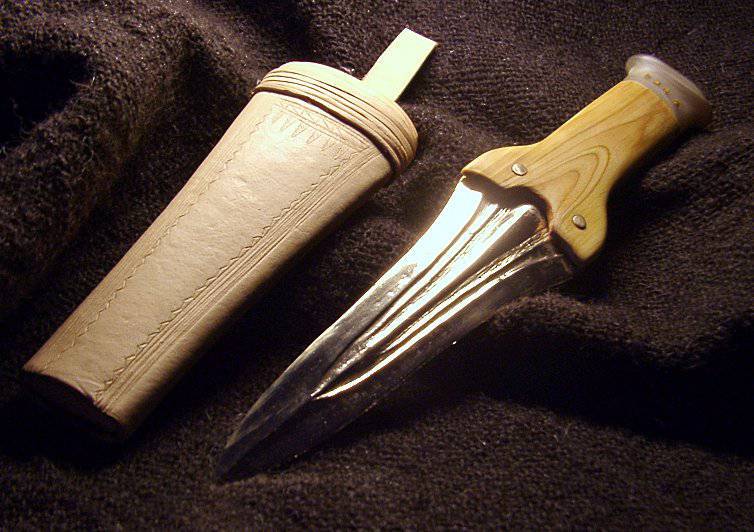
Bronze knife from the era of early bronze. Apparently, valuable bronze was saved in this way, since archeologists found a lot of treasures with defective castings, scrap and individual pieces of metal - that is, they hid everything that had at least some value.
Then the metal became more. But the inertia of people's thinking was such that daggers, for example, continued to cast entirely in the form of old samples with separate wooden handles. Moreover, they also reproduced the expansion of the back part of the blade, which was for the most part completely unnecessary, and the rivets were unnecessary, all the more, since now they no longer held anything together and only performed a decorative function.
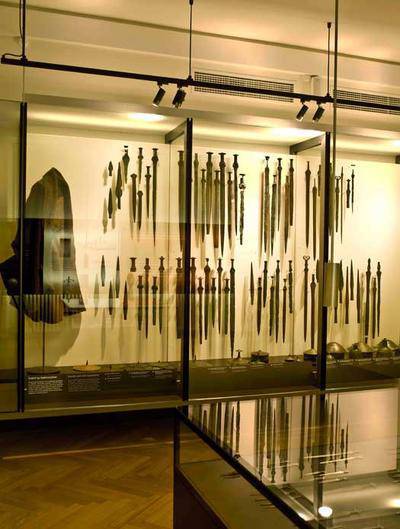
Bronze swords and daggers are very much, which indicates the wide distribution of such products. And the showcase at the National Museum of Denmark is the best confirmation of this.
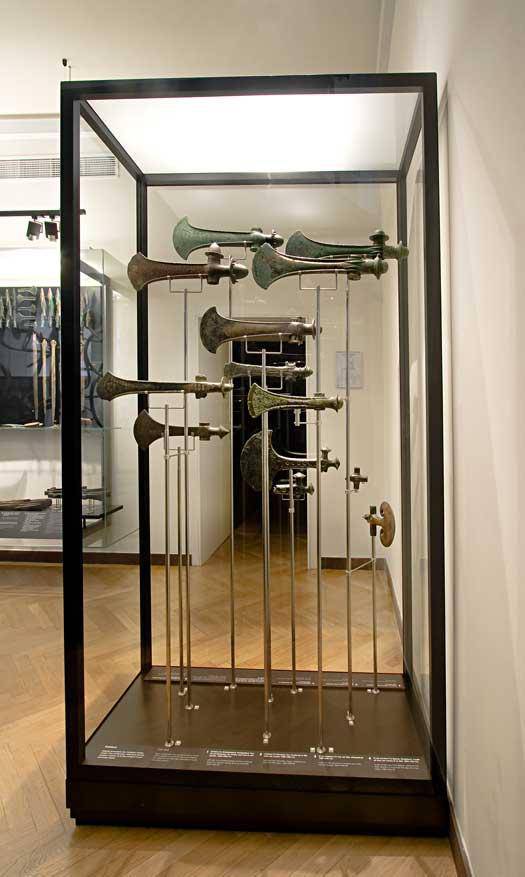
However, not only swords and daggers were the weapons of the people of the Bronze Age who lived at that time in Denmark. See how many bronze axes are displayed in this window!
However, there were also transitional patterns. The handle, the blade alone were cast in them separately, and then all this was joined together by rivets. But such daggers and swords were characteristic of the early Bronze Age. People quickly realized that why rivet, when you can cast. But, apparently, by virtue of tradition, they could not abandon the rivets at the junction of the blade with the handle.

A very beautiful dagger with a type-setting handle (and this is where the tradition of the type-setting handles of the prisoners of knives comes from ?!) and the blade riveted to it.
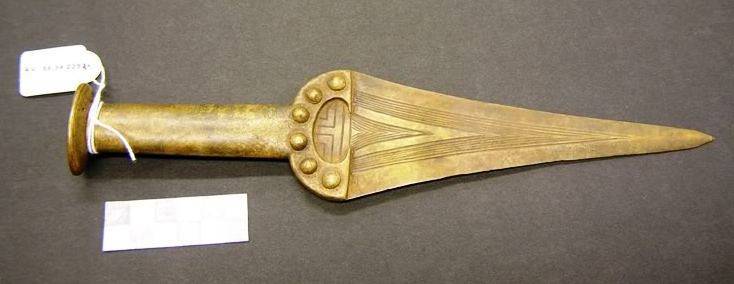
Amazingly beautiful and perfect one-piece bronze dagger from one private collection. Pay attention to how simple and at the same time it is aesthetic. There is nothing superfluous in it, and at the same time thin lines on the blade, massive rivets and a very simple handle give the impression of absolute completion. To him, as they say, there is nothing to add and nothing to subtract from it. Well, its form is also traditional and serves as the best proof of the inertia of human consciousness.
Of course, archaeologists are greatly helped by the fact that the people of the Bronze Age were pagans and buried their dead with rich posthumous gifts. This is where the bronze was not spared. However, they find valuable products of ancient gunsmiths not only in the graves ...
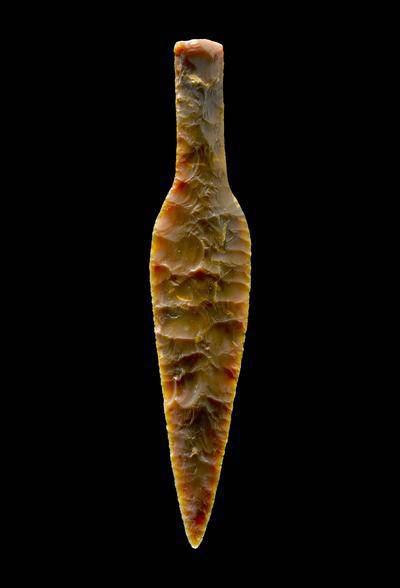
In the swamps of Denmark, not only bronze daggers are found, but also stone ones, that is, there was a stone age in the same way as in other places, but then it was replaced by the “age of metals”.
It was the case that in 1952, the Dane Thorvald Nielsen dug a dredging ditch in a small swamp in the town of Rorby in the western part of Zeeland. And it was there that he found the ornamented curved sword of bronze, which was stuck in the turf. The sword clearly belonged to the beginning of the Bronze Age, around 1600 BC, and was the first such discovery in Denmark. By the way, notice how similar both he and the dagger in the above handle photo are similar, which means that this form of the top was widespread. The sword was transferred to the National Museum in Copenhagen as an exhibit, but the history of the curved sword did not end there. In the 1957 year, when another Dane named Torvald Jensen was digging potatoes around the same place, he found another such sword. The second curve of the sword was decorated as the first, but it also had an image of the ship. This turned out to be the most ancient image of a ship in Denmark!
For an archaeologist, the gift of fate is not an excavated ancient mound. As a rule, this is someone's burial, and, usually, the burial is of the Bronze Age. And here they are very lucky with Denmark. About 86000 prehistoric mounds have been discovered on its territory, of which around 20000, according to experts, belong to the Bronze Age. Well, and they are found everywhere in the territory of modern Denmark, which suggests that it was densely populated in the past.
But besides the mounds in Denmark there are also swamps. And now they have become a real treasure trove for archaeologists. And what only they do not find, for example, among the most interesting "swamp finds" are ... bronze shields, which were made in central Europe in the period 1100 - 700. BC. Such bronze shields were known from Italy in the south to Sweden in the north, from Spain and Ireland in the west to Hungary in the east. It can be considered proven that the shields of such a thin metal could not have a military purpose. But for ritual purposes - as you like. Such shields were considered solar symbols and were closely associated with the worship of the gods and the forces of nature. In the Scandinavian rock carvings, pictures of round shields can be seen in connection with ritual dances, so their cult purpose is certain. But how were they found? This happened back in 1920, when two workers came to the editor of the local newspaper Jensen and brought two bronze shields, which they found in the Zörup Moze swamp during the development of the peat bog. The largest shield was badly damaged by a shovel. The finding was immediately reported to the National Museum, which began excavations. Workers reported that the shields were in the swamp vertically at a short distance from each other. Archaeologists have found this place, but there was nothing else there.
In the development of peat in a small swamp in Svenstrup in Himmerland in July 1948, Christian Jorgensen made another fantastic discovery. It was a beautiful bronze shield of the late Bronze Age. He handed the shield to the museum, and received a good reward for it - enough money to pay for a new roof for his farm.
Experts immediately noticed that these shields were made of a very thin bronze sheet. Experiments with copies of these shields have shown that they are completely useless in battle. Their thickness allows you to pierce the metal anywhere, and if you strike the shield with the same bronze sword, it will fall apart almost in half. This suggests that these shields were used exclusively for ritual purposes, but that at the same time people were still trying to save bronze. After all, a thicker bronze sheet requires less work than a thin one.
Here it is, this exquisite buckle.
And this is a Danish banknote on which the Danes placed its image and, it should be noted that many Danish banknotes used to be decorated with images of archaeological finds from the Stone and Bronze Age in Denmark!
It should be noted that the ancient Danes (or how they called themselves at that time?) Were masters of foundry. For example, a plate for a belt dated to 1400 BC, covered with elegant spiral patterns, is exhibited at the National Museum of Copenhagen. Found it back in 1879 year, again in the peat bog in North Zealand. Moreover, the worker who found it, handed over his find to the owner, and the latter, not knowing her and the other “coppers” of the real price, threw into the garbage heap, where they were noticed by a policeman who accidentally glanced at him. So, the manufacturing technology of such a plate was very original: a spiral of gold wire was inserted into a wax model, according to which the clay form was made. Then it warmed up, wax flowed out and molten bronze poured into it. Everything seems to be simple. But this plate was very thin, so real skill was required to alloy gold with bronze in such a way.
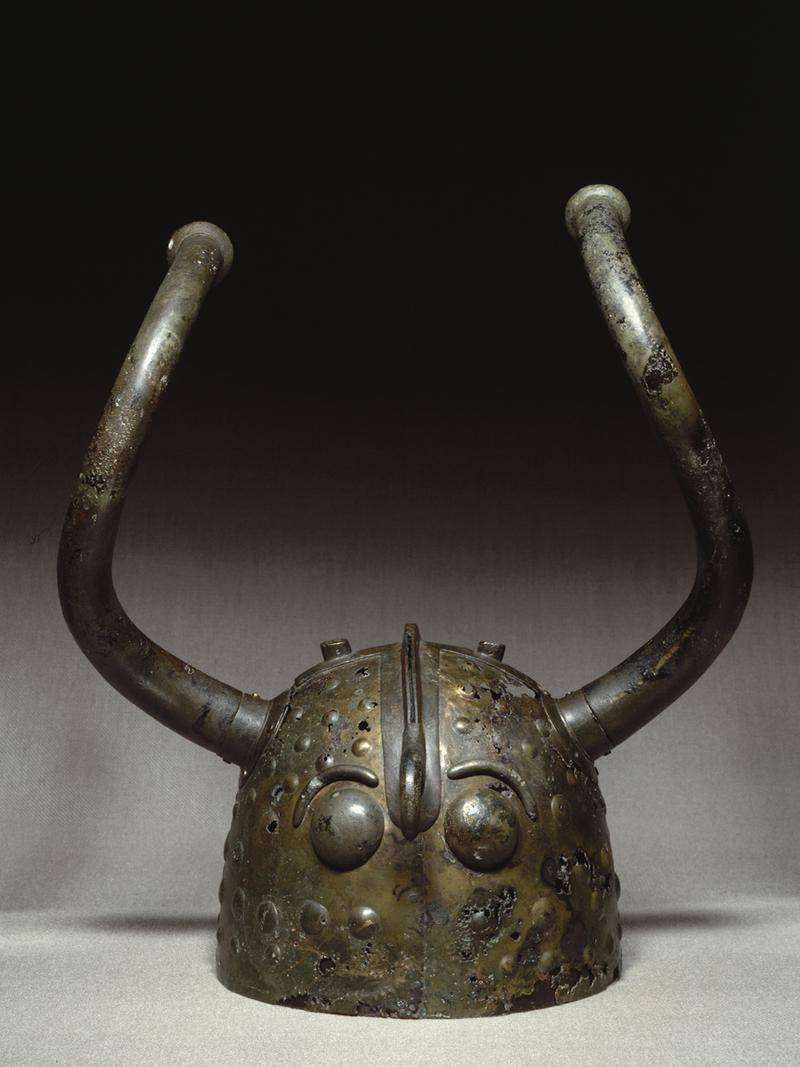
"Horned" helmet from Viksa.
And then in Weeks in Zealand, one of the workers dug two almost identical horned helmets made of bronze, made using the “lost form” method. They were decorated with umbrons, eyes, beaks and were made at the beginning of the first millennium BC. And again, it could not be helmets for combat. They were used in religious ceremonies, and then simply drowned in a swamp as a sacrifice to unknown deities. Interestingly, one of the helmets was placed on a preserved wooden tray, which, by the way, is not surprising, since peat has excellent preservative properties.
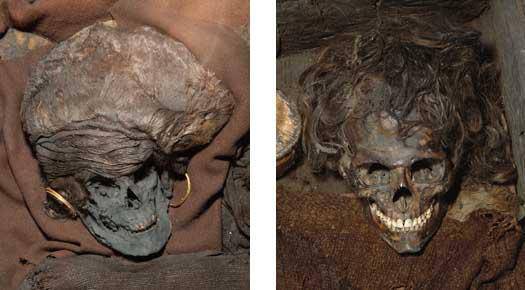
Mummies of women from Scrodstrupf. As you can see, thanks to the peat, they are well preserved.
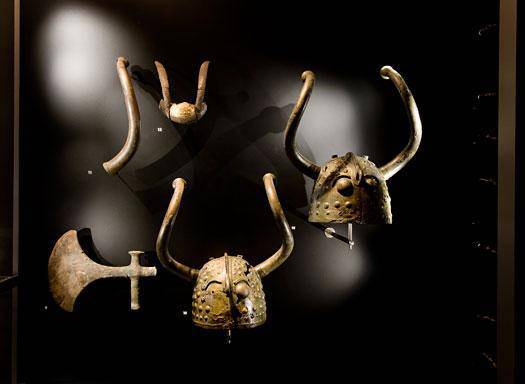
Both wyx helmets and related finds.
True, it is not entirely clear where these “helmets from Viksa” were made. Perhaps on the spot, where they were found, and perhaps it was in Central Europe or Northern Germany. In any case, numerous rock carvings of people wearing horned helmets, especially from western Sweden, suggest that the cult of the “horned man” was very popular here. Well, the “life path” of the objects of this cult was ended again ... in the swamp!
Lurs were also thrown there - huge bronze-cast pipes in the form of ox horns (c. 1000 BC), which in the same Denmark found 39 pieces. And they are found only in the swamps! That is, they were first made, spending valuable bronze, then they were trumpeted for some time, and then, together with shields, helmets and fine buckles for belts, were thrown into the swamp, and necessarily with a pair.
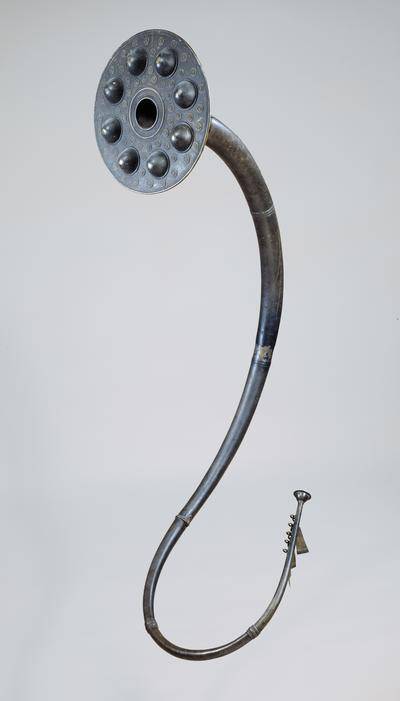
"Lure from Brudevalte". And this is how the “pipe” looked, and it was ... one-piece!
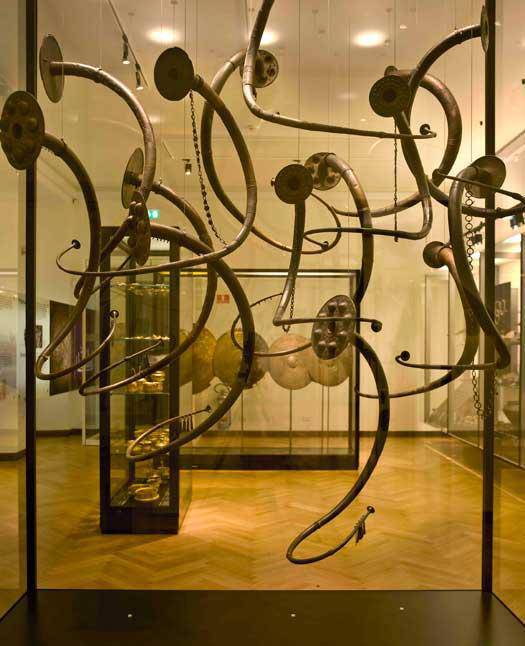
But their whole showcase!
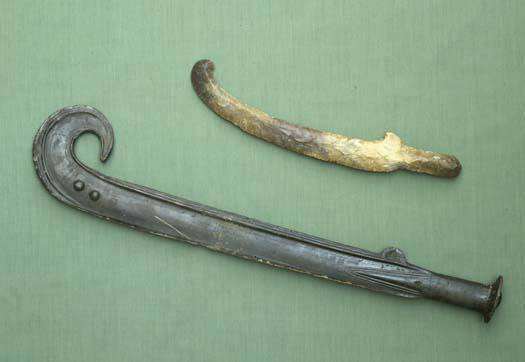
Here all detailing of one of these swords is well visible. This is clearly a ritual object, and quite massive. And here is the question - what did he depict? After all, this is clearly a sword, but it is also obvious that such swords cannot be fought. Then why was he given exactly this form?
But back to the swords of Rorby. Their form is unique in that ... they were originally made not combat. After all, can hardly be considered a combat sword, devoid of a point and without a sharpened blade. However, they did not save bronze, unlike shields. That is, the mercy of the ancestors or the “marsh gods” was more important for the ancient inhabitants of Denmark than the price of metal, or they had it in abundance!
Former copper mine in Cyprus. Copper was mined here, and it was from here that all Europe was supplied with this metal. But tin was mined in the British Isles, which the ancients called Tin. And maybe that is why in Denmark, which lay on the path of the ancient metal trade routes, there was just so much bronze that its products were not only laid into the graves of the dead, but also thrown into the marshes of the gods?
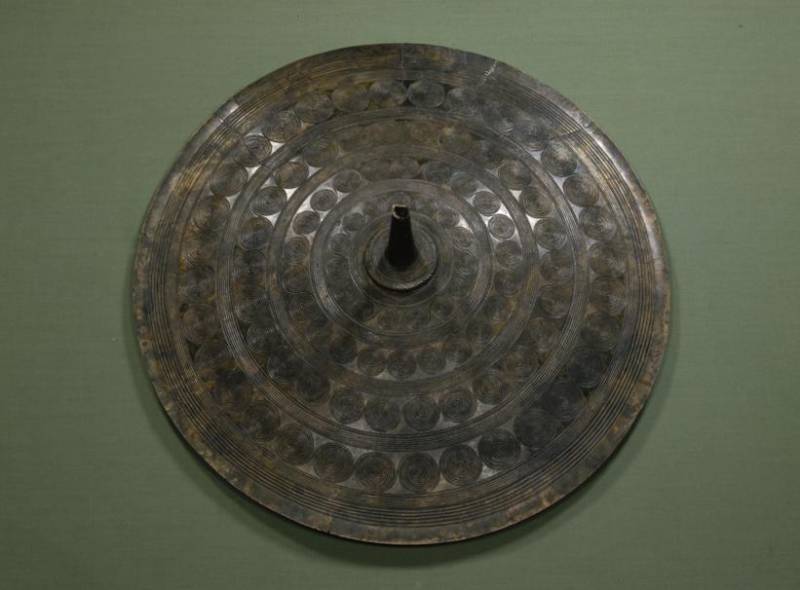
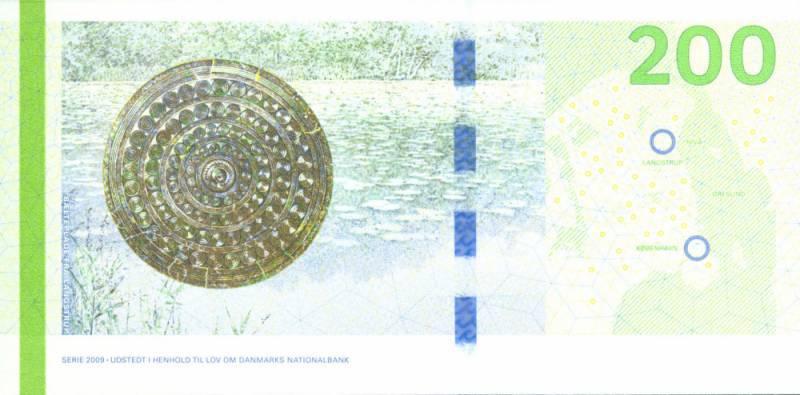
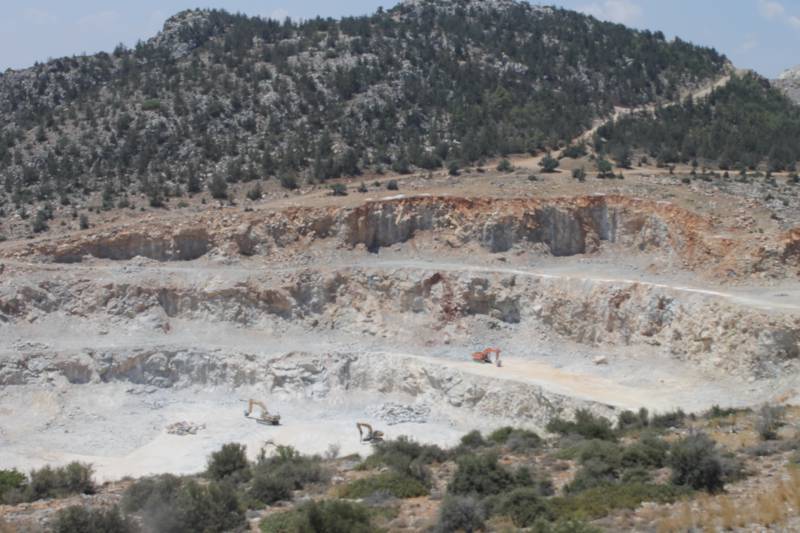
Information